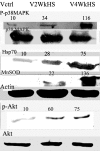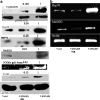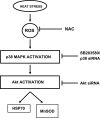Heat stress upregulates chaperone heat shock protein 70 and antioxidant manganese superoxide dismutase through reactive oxygen species (ROS), p38MAPK, and Akt
- PMID: 19291423
- PMCID: PMC2866949
- DOI: 10.1007/s12192-009-0109-x
Heat stress upregulates chaperone heat shock protein 70 and antioxidant manganese superoxide dismutase through reactive oxygen species (ROS), p38MAPK, and Akt
Abstract
Chinese hamster lung fibroblasts V79 cells were treated with heat stress for 4 weeks with short duration (15 min) heat shock every alternate day in culture. It was observed that Hsp 70 and the antioxidant enzyme MnSOD became overexpressed during the chronic heat stress period. Both p38 MAPK and Akt became phosphorylated by chronic heat stress exposure. Simultaneous exposure to SB203580, a potent and specific p38MAPK inhibitor drastically inhibited the phosphorylation of p38MAPK and Akt. Furthermore, exposure to SB203580 also blocked the increase in Hsp70 and MnSOD levels and the elevated SOD activity brought about by chronic heat stress. Heat shock factor 1 (HSF1) transcriptional activity and nuclear translocation of HSF1 were prominently augmented by chronic heat stress, and this amplification is markedly reduced by concomitant exposure to SB203580. Also, activations of p38MAPK and Akt and upregulations of Hsp70 and MnSOD were observed on exposure to heat shock for a single exposure of longer duration (40 min). siRNA against p38MAPK notably reduced Akt phosphorylation by single exposure to heat stress and drastically diminished the rise in Hsp70 and MnSOD levels. Similarly, siRNA against Akt also eliminated the augmentation in Hsp70 and MnSOD levels but p38MAPK levels remained unaffected. Heat stress produced reactive oxygen species (ROS) in V79 fibroblasts. N-acetyl cysteine blocked the increase in phosphorylation of p38MAPK, amplification of Hsp70, and MnSOD levels by heat stress. Therefore, we conclude that heat stress-activated p38MAPK which in turn activated Akt. Akt acted downstream of p38MAPK to increase Hsp70 and MnSOD levels.Concise summary: Thermal injury of the skin over a long period of time has been associated with development of cancerous lesions. Also, in many cancers, the cytoprotective genes Hsp70 and MnSOD have been found to be overexpressed. Therefore, we considered it important to identify the signaling elements upstream of the upregulated survival genes in heat stress. We conclude that heat stress activated p38MAPK which in turn activated Akt. Akt mediated an augmentation in Hsp70 and MnSOD levels working downstream of p38MAPK.
Figures






Similar articles
-
Hyperthermia increases HSP production in human PDMCs by stimulating ROS formation, p38 MAPK and Akt signaling, and increasing HSF1 activity.Stem Cell Res Ther. 2022 Jun 3;13(1):236. doi: 10.1186/s13287-022-02885-1. Stem Cell Res Ther. 2022. PMID: 35659731 Free PMC article.
-
P38MAP kinase, but not phosphoinositol-3 kinase, signal downstream of glutamine-mediated fibronectin-integrin signaling after intestinal injury.Nutr J. 2013 Jun 21;12(1):88. doi: 10.1186/1475-2891-12-88. Nutr J. 2013. PMID: 24499047 Free PMC article.
-
Pro-survival effects of repetitive low-grade oxidative stress are inhibited by simultaneous exposure to Resveratrol.Pharmacol Res. 2008 Nov-Dec;58(5-6):281-9. doi: 10.1016/j.phrs.2008.08.007. Epub 2008 Sep 2. Pharmacol Res. 2008. PMID: 18812223
-
Regulation of survival gene hsp70.Cell Stress Chaperones. 2012 Jan;17(1):1-9. doi: 10.1007/s12192-011-0290-6. Epub 2011 Aug 28. Cell Stress Chaperones. 2012. PMID: 21874533 Free PMC article. Review.
-
Heat shock proteins: a history of study in Russia.Cell Stress Chaperones. 2021 Jul;26(4):617-627. doi: 10.1007/s12192-021-01219-z. Epub 2021 Jun 28. Cell Stress Chaperones. 2021. PMID: 34184179 Free PMC article. Review.
Cited by
-
The Effects of Graded Levels of Calorie Restriction: X. Transcriptomic Responses of Epididymal Adipose Tissue.J Gerontol A Biol Sci Med Sci. 2018 Mar 2;73(3):279-288. doi: 10.1093/gerona/glx101. J Gerontol A Biol Sci Med Sci. 2018. PMID: 28575190 Free PMC article.
-
Regulation on tumor metastasis by Raf kinase inhibitory protein: New insight with reactive oxygen species signaling.Tzu Chi Med J. 2021 May 4;33(4):332-338. doi: 10.4103/tcmj.tcmj_296_20. eCollection 2021 Oct-Dec. Tzu Chi Med J. 2021. PMID: 34760627 Free PMC article. Review.
-
Genetic susceptibility of postmenopausal osteoporosis on sulfide quinone reductase-like gene.Osteoporos Int. 2018 Sep;29(9):2041-2047. doi: 10.1007/s00198-018-4575-9. Epub 2018 May 31. Osteoporos Int. 2018. PMID: 29855663
-
Effects of melatonin on the proliferation and apoptosis of sheep granulosa cells under thermal stress.Int J Mol Sci. 2014 Nov 14;15(11):21090-104. doi: 10.3390/ijms151121090. Int J Mol Sci. 2014. PMID: 25405739 Free PMC article.
-
Convergent sets of data from in vivo and in vitro methods point to an active role of Hsp60 in chronic obstructive pulmonary disease pathogenesis.PLoS One. 2011;6(11):e28200. doi: 10.1371/journal.pone.0028200. Epub 2011 Nov 28. PLoS One. 2011. PMID: 22140545 Free PMC article.
References
Publication types
MeSH terms
Substances
LinkOut - more resources
Full Text Sources

